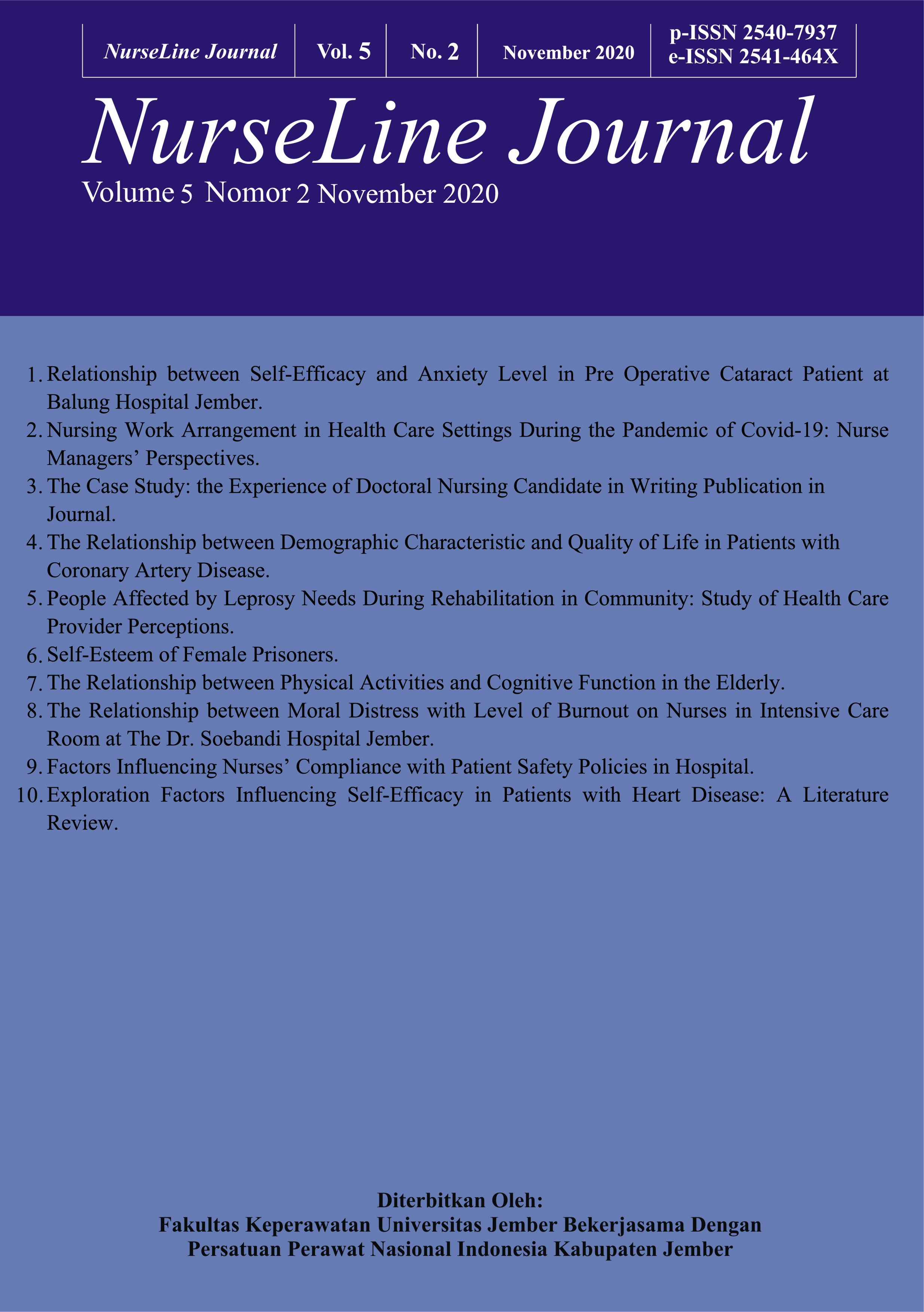Nursing Work Arrangement in Health Care Settings During the Pandemic Of Covid-19: Nurse Managers’ Perspectives
DOI:
https://doi.org/10.19184/nlj.v5i2.20544Keywords:
COVID-19, Nurse, Manager, Pandemic, Work Arrangement, Health Care Settings During the Pandemic Of Covid-19Abstract
Nurses are health service providers playing pivotal role and serving at the forefront of tackling COVID-19. As such, their health and safety are pivotal. Therefore, a policy is needed in arranging their work system in response to COVID-19 pandemic. The work arrangement denotes an effort to prevent human-to-human infection transmission of COVID-19. However, the nursing work system adjustment model is not yet know. The aim of the study is to explore a model for adjusting the work system of nurses in health care facilities during the COVID-19 pandemic, from the perspective of nurse managers. This study applied descriptive qualitative method. It involved 9 (nine) managers who were recruited from 2 (two) public hospitals which became the national reference for handling COVID-19. These subjects were chosen using purposive sampling technique. Data collection employed semi-structured interviews through virtually telephone and conference. Resultant data was analyzed using content analysis. The study has unraveled five main categories related to the adjustment of the nursing work system during the pandemic, including the management of nurse personnel, regulation at work, arrangement of work patterns, adjustment of work procedures, and flexibility of work systems. Through the work system regulation, hospital managers have implemented the principle of maintaining health, safety and security of nurses while working in health care facilities. The adjustment of the nursing work system aims to reduce the negative impact of the health crisis and reduce anxiety for nurses. This is mainly because the level of anxiety associated with COVID-19 may pose adverse effects on nurses’ wellbeing.
Downloads
References
Hoedl, M., S. Bauer, dan D. Eglseer. 2020. Influence of nursing staff working hours on the stress level during the covid- 19 pandemic: a cross-sectional online survey short running title: working hours and stress list of all authors. 1–18.
Huang, L., G. Lin, L. Tang, L. Yu, dan Z. Zhou. 2020. Special attention to nurses ’ protection during the covid-19 epidemic. 10–12.
ILO. 2020. ILO standards and covid-19 (coronavirus). International Labour Organization. 1–37.
International Labour Organization. 2020a. COVID-19 and the World of Work: Impact and Policy Responses
International Labour Organization. 2020b. In the Face of a Pandemic: Ensuring Safety and Health at Work
Kementerian Kesehatan Republik Indonesia. 2020. Tanya Jawab Novel Coronavirus (2019-NCoV)
Kim, H., J. S. Sefcik, dan C. Bradway. 2017. Characteristics of qualitative descriptive studies: a systematic review. Research in Nursing and Health. 40(1):23–42.
Kluger, D. M., Y. Aizenbud, A. Jaffe, F. Parisi, L. Aizenbud, E. Minsky-Fenick, J. M. Kluger, S. Farhadian, H. M. Kluger, dan Y. Kluger. 2020. Impact of healthcare worker shift scheduling on workforce preservation during the covid-19 pandemic. Infection Control & Hospital Epidemiology. 1–3.
Kompas. 2020. IDI: Lebih Dari Satu Semester Pandemi, Angka Kematian Tenaga Kesehatan Semakin Mengkhawatirkan.
Labrague, L. J. dan J. A. A. D. los Santos. 2020. COVID-19 anxiety among front-line nurses : predictive role of organisational support , personal resilience and social support. Journal of Nursing Management. (July):1–9.
Limiñana-Gras, R. M., M. P. Sánchez-López, A. I. S. S. Román, dan F. J. Corbalán-Berná. 2013. Health and gender in female-dominated occupations: the case of male nurses. Journal of Men’s Studies. 21(2):135–148.
Liu, Q., D. Luo, J. E. Haase, Q. Guo, X. Q. Wang, S. Liu, L. Xia, Z. Liu, J. Yang, dan B. X. Yang. 2020. The experiences of health-care providers during the covid-19 crisis in china: a qualitative study. The Lancet Global Health. 8(6):e790–e798.
Peters, D. M. D. 2020. Anmf evidence brief covid-19 : provisions for casual nurses. Australian Nursing & Midwifery Federation. 1–7.
Shanafelt, T., J. Ripp, dan M. Trockel. 2020. Understanding and addressing sources of anxiety among health care professionals during the covid-19 pandemic. JAMA. 323(21):2133–2134.
Siqueira, A. J. B., G. F. Machado, J. do C. Costa, L. de F. Branco, M. Montressor, S. de O. Nonato, dan E. A. D. A. Silva. 2019. Flexible Work Practice in Nursing. 9. Journal of Chemical Information and Modeling.
World Health Organization. 2020. WHO Director-General’s Opening Remarks at the Media Briefing on COVID-19 - 11 March 2020. https://www.who.int/dg/speeches/detail/who-director-general-s-opening-remarks-at-the-media-briefing-on-covid-19---11-march-2020 [Diakses pada July 9, 2020].
Wu, X., S. Zheng, J. Huang, Z. Zheng, M. Xu, dan Y. Zhou. 2020. Contingency nursing management in designated hospitals during covidâ€19 outbreak. Annals of Global Health. 86(1):1–5.








